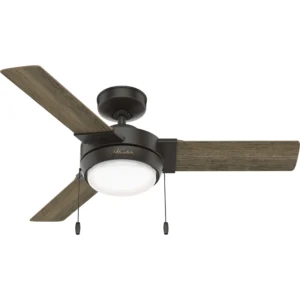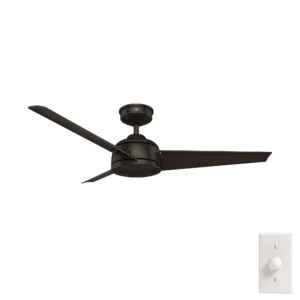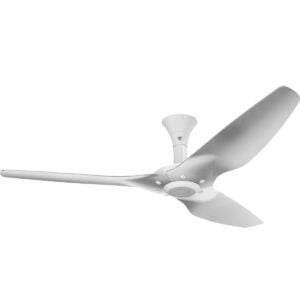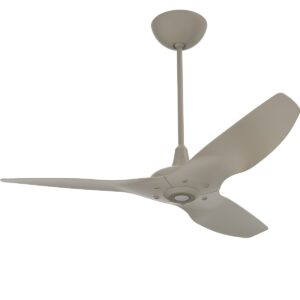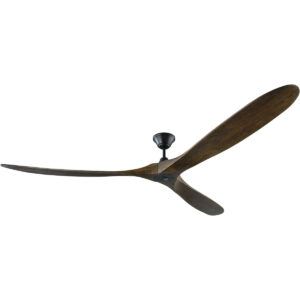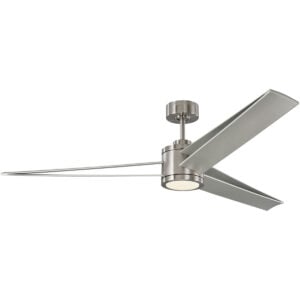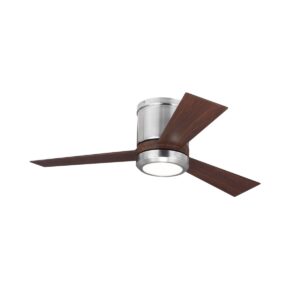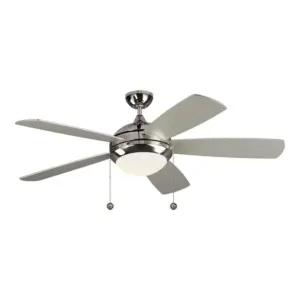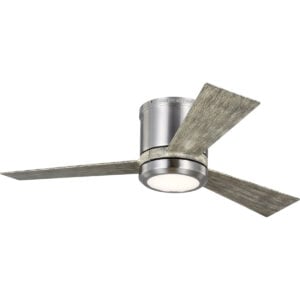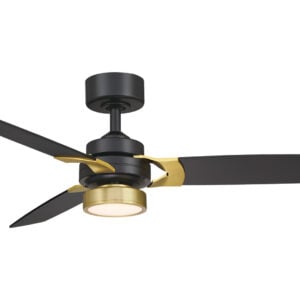Modern and Contemporary Ceiling Fans
Everything You Need to Know Before You Buy
When people refer to a ceiling fan as being modern, they could have a number of different ideas in mind. For one, they might be thinking of modern-era design.
A ceiling fan is a piece of home décor. It’s a fixture that stands out, adding character and ambiance to a living space, so choosing the right style is important.
Modern design is a broad term that typically refers to designs with clean, crisp lines, a simple colour palette and materials such as metal, glass and wood.
They also may be thinking of contemporary design. Though modern and contemporary design are different in many ways, they have important similarities. For example, both promote a minimalist aesthetic, clean architectural lines and an open-space feel.
These similarities make it easy for you to mix and match modern and contemporary furnishings — including ceiling fans — in your home to create your own signature style.
Modern Features
Today’s ceiling fans come with a variety of features to suit your preferences and needs.
Choosing the perfect ceiling fan for a room in your home starts with knowing both what style you like and what features you want your fan to have. This article will provide you with a good basic understanding of modern ceiling fans and, hopefully, help you make a purchase decision that’s right for you and your family.
Shopping for a Modern Ceiling Fan: Style, Convenience, Durability
Perhaps the first point you should consider when beginning the process of choosing a ceiling fan is how it looks and makes you feel. These aesthetic and psychological questions are crucial and must be considered upfront.
Because you don’t want to take your ceiling fan home and go to the trouble of installing it — only to realize that you don’t really like it.
Other related questions include: Will the ceiling fan’s design blend in with the existing décor? Will it contribute to your goal of creating a comfortable home? Will others in the family like it
You won’t have difficulty finding modern-looking ceiling fans to peruse and tire-kick. Modern design is popular in home décor, and many ceiling fan manufacturers offer a line of products with modern and contemporary styles and finishes.
If you’re interested in a modern ceiling fan for a room with a low ceiling, consider a low-profile, or “hugger,” design. With their compact form and sophisticated look, low-profile ceiling fans are the ideal addition to any room that has a modern look and limited ceiling height.
Also, modern flush mount ceiling fans can provide a sense of expansiveness since they reside close to the ceiling and remain out of the direct viewing angle.
On the other hand, if your room has a high ceiling, choose a ceiling fan with a modern style that suits your décor and mount it to your ceiling using a downrod.
Downrods are extensions that lower the fan to a height that offers the greatest cooling efficiency.
Ceiling Height and Fan Performance
For best performance, your ceiling fan should hang 8 feet to 9 feet above the floor. To calculate the length of the downrod, subtract the ceiling fan height you’ve decided on from the actual ceiling height.
For an ultra-modern look, choose finishes like chrome and stainless steel. And when you want to create a sense of antique elegance, go with finishes like brass, pewter and gold. Matte black is a great complement to most décor, including modern and contemporary, and almost never clashes with the existing color scheme.
Common Features Available in Modern Ceiling Fans: Lights, Remote, Action!
Lights
Lights are one of the most popular features that homeowners look for when shopping for ceiling fans. Many styles of modern ceiling fans are available with lights, with incandescent and LED lights being the most common types.
A key benefit of installing a ceiling fan with a built-in light is that it reduces clutter and conserves space. Your ceiling — and indeed your entire room — will look cleaner, sharper and more thoughtfully put together with a well-chosen ceiling fan-light combo.
Most modern ceiling fans with lights allow you to turn on both the fan and light at the same time. This design is more efficient and helps you avoid tripping over obstacles in a dark room. Additionally, some ceiling fans with lights feature dimmer mechanisms for controlling the brightness of the lighting.
Dimmer switches
Dimmer switches are an effective way of allowing you to adjust the lighting ambiance in a room, without the need to install multiple lighting fixtures with differing lighting levels.
Dimmers also save you money by lowering energy consumption and extending the lifetime of your light bulbs.
LED lights
Led lights are another modern touch that enhances today’s ceiling fans. Compared to incandescent lights, this type of lighting is more energy-efficient, produces less heat and lasts much longer.
If you’re installing a ceiling fan in a room that doesn’t need additional lighting, no problem. There is a wide selection of ceiling fans without lights available in the market, and many popular contemporary ceiling fan models are available with or without lights.
Remote controls
Remotes are another product feature commonly found in modern, contemporary ceiling fans.
With a hand-held remote control, you have access to your fan's functions from anywhere in the room. In modern ceiling fans, remotes not only provide convenience, they also improve safety.
Older ceiling fans were often frequently operated using their pull chains. This creates the potential for injury if the user over-stretches or tumbles from a chair when reaching for the chain.
In many contemporary ceiling fans, the remote control can be paired with smart technology to provide even more convenience and flexibility.
Modern Ceiling Fans with Smart Home Technology – Just How Smart Are They?
Smart home technology connects your ceiling fan to your WiFi network. You control and program the fan through an app on your mobile device or through commands that you speak to a virtual assistant like Alexa, Siri or Cortana.
A contemporary ceiling fan equipped with the latest smart technology can be synchronized with your thermostat to improve energy efficiency and save money. This type of smart fan will turn on and off automatically based on the rising and falling temperature in your home.
By generating airflow, the fan helps amplify the performance of both your air conditioner in summer and your furnace in winter.
Pre-schedule when your fan turns on and off
You can also program smart ceiling fans to turn on or off at certain times that coincide with your arrival from work, your usual bedtime or other regularly occurring events. Similarly, you can program your modern smart ceiling fan to run for a certain length of time, shut off for a period of time and then turn back on at some later point. How convenient is that!
Some smart fans have built-in motion detectors that sense when you are near and can automatically turn on the fan's light. This feature increases your safety by letting you navigate easily a lit room that might otherwise be too dark.
You can also deter intruders by programming your smart ceiling fan to turn on its lights at regular intervals when you’re not home. And since you operate the fan through an app on your phone, you can do this at any time and from wherever you might be, whether at a friend’s home, the office or away on vacation
Features to Consider When Shopping for a Modern Ceiling Fan
- Materials: Ceiling fans are made from a range of materials, including bronze, nickel, chrome, brass and stainless steel.
- Number of blades: Most fans have 3, 4, 5 or 6 blades. Occasionally, you may see a fan that has two blades or more than 6 blades.
- Mounting style: Ceiling fans can be installed using a flush mount (mounted directly against the ceiling), downrod mount (allows the fan to hang at the correct height from a higher ceiling) or angled mount (used to attach a fan to a slanted ceiling, such as in an attic, nook or loft). Typically, ceiling fans are mounted a minimum of 7 feet above the floor and at least 18 inches away from any walls.
- Blade style: Most ceiling fans have blade spans that range from 29 inches to 96 inches. Common blade shapes include curved, flat and elliptical.
- Finish and colour: Popular finishes include white, black, antique bronze, antique nickel, pewter, antique brass, gold and black matte. Modern chrome ceiling fans are often available in a natural or polished finish. Modern stainless-steel ceiling fans often have a silver-tone finish.
- Light fixture kit: Not all ceiling fans are light-kit compatible. The light kit may be included or may need to be purchased separately.
- Remote control: Most modern ceiling fans come with a hand-held remote control, in addition to the standard wall-mounted control.
- Built-in smart technology: More and more smart ceiling fans can be synchronized with your heating-and-cooling system to create year-round savings. Other smart technology benefits include the ability to program run times and shut-off times and to synchronize your fan with other smart home appliances.
More Reasons to Buy a Modern Ceiling Fan: Energy Efficiency and Year-Round Savings
Ceiling fans with DC motors use less energy
Increasingly, modern ceiling fan manufacturers are designing models equipped with energy-efficient DC motors. Compared to ceiling fans that use AC motors, ceiling fans with DC motors reduce energy consumption by as much as 70 percent.
Reversible Ceiling Fans
Modern or contemporary ceiling fans are made for use in summer and winter. Many people are unaware that a ceiling fan will not only cool your house in summer but also help keep it at a warm, comfortable temperature in winter.
The trick is to get the fan direction right. Look for a switch, typically located on the motor, that adjusts the blades to turn either clockwise or counterclockwise.
Blade Direction Guide
SUMMER = Set the blades to turn in a counter-clockwise (or forward) direction.
WINTER = Set the blades to turn in a clockwise (or reverse) direction.
How your ceiling fan keeps you cool in summer
When running counter-clockwise, the blades of the fan push air downwards. The moving air helps evaporate perspiration and creates a wind-chill effect, which makes you feel cooler without changing the room temperature.
If you run your ceiling fan in a counter-clockwise direction in the hotter months, you won’t need to turn on your air conditioner as often, saving you money.
How your ceiling fan keeps you warmer in winter
When running clockwise, the fan's blades push air up towards the ceiling. This causes the warm air that collects at the ceiling (remember, warm air rises) to move away, travel down the walls and spread out across the room.
As a result, your room at the sitting and standing level will feel warmer, allowing you to lower your thermostat and use less energy.
Maximizing the potential savings
Consider combining the energy efficiency of a DC motor with the practice of strategically using your ceiling fan in summer and winter to reduce your need to run your air conditioner and furnace.
You’ll save more on your energy bill, leaving you with extra cash in your pocket to do the things you like.
Factors that Affect the Efficiency of Modern Ceiling Fans
Few blades, more air movement
In general, the more blades on the fan, the less air it moves. The reason is that every additional blade increases the drag on the motor, slowing it down. From an aesthetic standpoint, a fan with, say, 5 blades may look better, but a 3- or 4-bladed fan with equal motor power will keep you cooler.
Airflow metrics
Airflow refers to the amount of air a ceiling fan delivers. It’s measured in cubic feet per minute, or CFM for short. Look for the CFM number on the fan’s box – the higher the number, the more air movement.
Blade span
The blade spans of ceiling fans typically range from 29 inches to 96 inches, the most popular being the 52-inch. A 52-inch blade fan is an appropriate size for rooms that are 225 to 400 square feet, while a 42-to-44-inch blade works better in spaces ranging from 144 square feet to 225 square feet.
Blade pitch
Pitch refers to the angle, indicated in degrees, of the fan's blades. Typically, the higher the blade pitches, the more air that gets moved (as measured in CFM). However, a higher pitch does not always mean that a given ceiling fan model is a better option. Some models use higher blade pitch to make up for a smaller, less efficient motor.
Blade cleanliness
Blades that are covered in dust and dirt create more burden on the motor. According to Consumer Reports, it’s a good idea to wax the blades of your ceiling fan with car wax to prevent dust from sticking.
Choosing the Right Size Ceiling Fan for your Room
Choosing the right ceiling fan makes all the difference in how well your fan will perform to keep you comfortable.
In general, ceiling fans with very short blades, between 22 inches and 34 inches, are better suited for smaller, enclosed spaces, while those with longer blades, between 72 inches and 96 inches, are often used outdoors or in industrial settings. To determine the size you need, measure the room where the ceiling fan will be installed and follow these guidelines:
